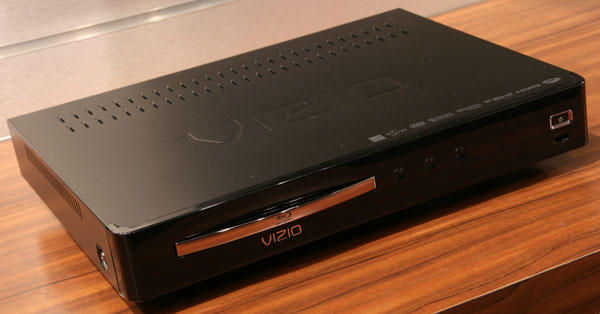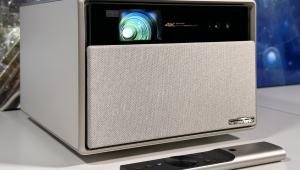CEA Line Shows, Day 1

Vizio introduced a surprising number of products that weren't shown at CES only six months ago. Of particular interest were demos of both active and passive-polarized 3D flat panels, which gives the consumer a choice between full HD resolution for each eye with expensive shutter glasses or half vertical resolution for each eye with inexpensive passive glasses.
Pictured above is the 42-inch XVT3D424SV, an LED edge-lit LCD that uses active glasses and refreshes the screen at 480Hz (actually 240Hz with edge-light flashing). Another line using active glasses includes two sizes of LED-backlit LCD TVs—47 and 55 inches—with 120 zones of local dimming. These models should be shipping by the end of the year for undisclosed prices.
Also on display was the 65-inch XVT3D654SV, an LED edge-lit LCD using passive-polarized glasses. Watching without the glasses, I could see the "interleaved" nature of the L/R separation, especially on text, but things looked reasonably good in a quick demo with the glasses on. This TV should be available in 2011, but no pricing was revealed.

The active-glasses display was showing content from Vizio's newly announced 3D Blu-ray player, shown in the lower portion of this photo. No model number, pricing, or availability were announced, but knowing Vizio, it'll be a bargain. Also introduced at the show were several new soundbars, including the VHT510 shown in the upper part of this photo. This model not only provides a wireless subwoofer, but also two satellite surround speakers that connect to the subwoofer; very cool for $350!

Perhaps even cooler is the VBR120 (pictured here), a new Blu-ray player for—get this—$99! It provides Ethernet connectivity (no WiFi) to access Vizio Internet Apps (VIA), which are also available on all Vizio TVs, and it will be available in the Fall. If you want WiFi, you can step up to the VBR220, which will be available this month for $189. Rounding out Vizio's Blu-ray players is the VBR231, which offers dual-band WiFi at 2.4 and 5GHz, automatically selecting the band with less traffic to assure the best possible media streaming. It will be available next month for $199.

Monster Cable introduced several new products, including universal active-shutter 3D glasses called MonsterVision Max3D. Unlike the XpanD X103, Monster's glasses don't use IR—they use RF, so line of sight isn't an issue. The transmitter connects to the TV with a VESA cable, or it can sense the TV's IR sync signal and convert that to RF. Even better, one transmitter can easily address more than 1000 pairs of glasses, which run on a rechargeable battery that can last more than 800 hours on a single charge.
The MonsterVision Max3D glasses and transmitter will be available in August in a combo pack with one of each for $250; extra pairs of glasses will be $170, and the transmitter will cost $60.
At first, I was very excited by the prospect of another player in the universal 3D-glasses game, but the more I thought about it, less excited I became. The real beauty of universal glasses is that they can be used with any 3D TV, which these can—as long as you take the transmitter with you! Universal IR glasses such as the XpanD X103 are much easier to share among different brands of 3D TV. Yes, the Monster system lets many more people watch the same TV than if they were wearing IR glasses, but most 3D TVs are relatively small, so not that many people can comfortably watch them anyway.

Anthem showed four new A/V receivers at the show—the MRX 300 ($1000), 500 ($1500), 700 ($2000, shown here beneath the BLX 200 Blu-ray player), and 900 ($4000). The big news here is that all four include Anthem Room Correction (ARC), previously available only in the company's high-end D2v ($8500) and AVM 50v ($6000) pre/pros. Also, all provide HDMI 1.4a connections (seven inputs in the 900, four in the others, one output on all models) with 3D pass-through, Audio Return Channel, and Ethernet over HDMI in a firmware update scheduled for November.
The MRX 900 provides nine channels of amplification at 140Wpc as well as VXP video processing. The others offer seven amp channels; the company reps didn't know which video processor is used in these.
- Log in or register to post comments





























































